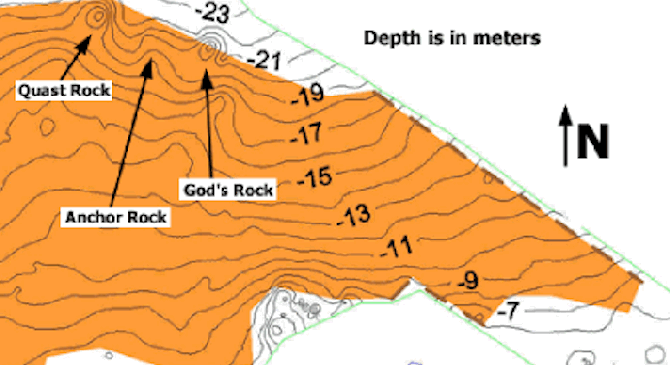 Facebook
Facebook
 X
X
 Instagram
Instagram
 TikTok
TikTok
 Youtube
Youtube

The following comes from the San Diego website DiveBums.com
Of these four named rocky pinnacles grouped together offshore of Point La Jolla, the best known is Quast Rock, which sits way out northwest past Boomer in about 65 feet of water. Generally, it's a boat dive site—unless you're feeling extraordinarily ambitious on your surface swim. There are several known "rocks" (stubby pinnacles) out there—Quast Rock, T Rock, Anchor Rock and God's Rock—and you will frequently see people in small skiffs or kayaks out fishing there.
All of these sites are large rock outcroppings right on the edge between the rocky reef of La Jolla and the sand falling away offshore at depths of 65—75 feet. Relief on these outcroppings varies from 5 feet to probably 20 feet. There are lots of interesting rock fingers, small caverns, holes, etc. This is also generally the edge of the kelp forest, so you not only have great rocky outcroppings to explore, but then you've got a built in, interesting ascent "line"... the kelp.
Quast Rock features a good size cavern on the side facing the sand, with a hole through the top of that cavern up to the large rock "plate" above.
T Rock features a quite large T-shaped rock on the inside, left corner (when facing from the sand side). This T-shaped rock is probably 10 feet tall and about that wide. At the outside, right corner you'll find a smaller mushroom shaped rock.
Anchor Rock had quite a few outcroppings, fingers, holes, and other interesting formations, including the massive formation on the far left (when facing from the sand side) which presumably gives the site its name: the massive rock there (probably 20 feet tall) looks very much like a classic anchor symbol.
God's Rock, like Quast Rock, is a little smaller than T Rock and Anchor Rock, but again provides some great rock formations to explore.


The following comes from the San Diego website DiveBums.com
Of these four named rocky pinnacles grouped together offshore of Point La Jolla, the best known is Quast Rock, which sits way out northwest past Boomer in about 65 feet of water. Generally, it's a boat dive site—unless you're feeling extraordinarily ambitious on your surface swim. There are several known "rocks" (stubby pinnacles) out there—Quast Rock, T Rock, Anchor Rock and God's Rock—and you will frequently see people in small skiffs or kayaks out fishing there.
All of these sites are large rock outcroppings right on the edge between the rocky reef of La Jolla and the sand falling away offshore at depths of 65—75 feet. Relief on these outcroppings varies from 5 feet to probably 20 feet. There are lots of interesting rock fingers, small caverns, holes, etc. This is also generally the edge of the kelp forest, so you not only have great rocky outcroppings to explore, but then you've got a built in, interesting ascent "line"... the kelp.
Quast Rock features a good size cavern on the side facing the sand, with a hole through the top of that cavern up to the large rock "plate" above.
T Rock features a quite large T-shaped rock on the inside, left corner (when facing from the sand side). This T-shaped rock is probably 10 feet tall and about that wide. At the outside, right corner you'll find a smaller mushroom shaped rock.
Anchor Rock had quite a few outcroppings, fingers, holes, and other interesting formations, including the massive formation on the far left (when facing from the sand side) which presumably gives the site its name: the massive rock there (probably 20 feet tall) looks very much like a classic anchor symbol.
God's Rock, like Quast Rock, is a little smaller than T Rock and Anchor Rock, but again provides some great rock formations to explore.
Comments